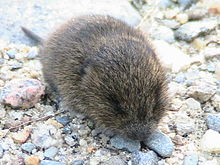Eastern meadow vole
[5] In east-central Ohio, eastern meadow voles were captured in reconstructed common cattail (Typha latifolia) wetlands.Eastern meadow voles have to eat frequently, and their active periods (every two to three hours) are associated with food digestion.[8][9] In Canada, eastern meadow voles are active the first few hours after dawn and during the two- to four-hour period before sunset.[5] Female eastern meadow voles reach reproductive maturity earlier than males; some ovulate and become pregnant as early as three weeks old.In peak years, their population densities may reach 150 per acre in marsh habitat (more favorable for eastern meadow voles than old fields).[15] Eastern meadow voles in optimal habitats in Virginia (old fields with dense vegetation) reached densities of 983/ha (398/ac); populations declined to 67/ha (27/ac) at the lowest point in the cycle.Reich[5] listed the following factors as having been suggested by different authors: food quality, predation, climatic events, density-related physiological stress, and the presence of genetically determined behavioral variants among dispersing individuals.[8] Optimal eastern meadow vole habitat consists of moist, dense grassland with substantial amounts of plant litter.Habitat selection is largely influenced by relative ground cover of grasses and forbs; soil temperature, moisture, sodium, potassium, and pH levels; humidity; and interspecific competition.[21] In Ohio, the effects of patch shape and proportion of edge were investigated by mowing strips between study plots.In winter, nests are often constructed on the ground surface under a covering of snow, usually against some natural formation such as a rock or log.[5][9] In summer and fall, grasses are cut into match-length sections to reach the succulent portions of the leaves and seedheads.[5] In winter, eastern meadow voles consume green basal portions of grass plants, often hidden under snow.[9] In an old-field community in Quebec, plants preferred by eastern meadow voles included quackgrass (Elytrigia repens), sedges, fescues (Festuca spp.[9] In Ohio, eastern meadow voles comprised 90% of the individual prey remains in long-eared owl (Asio otus) pellets on a relict wet prairie,[25] and in Wisconsin, eastern meadow voles comprised 95% of short-eared owl (A. flammeus) prey.The list of crops damaged by eastern meadow voles includes root and stem crops (asparagus, kohlrabi), tubers, leaf and leafstalks, immature inflorescent vegetables (artichoke, broccoli), low-growing fruits (beans, squash), the bark of fruit trees, pasture, grassland, hay, and grains.[27] In central New York, colonization of old fields by trees and shrubs was reduced due to seedling predation by eastern meadow voles, particularly under the herb canopy.[28] Management of eastern meadow vole populations in agricultural areas includes reduction of habitat in waste places such as roadsides and fencerows by mowing, plowing, and herbicide application.[9] Plastic mesh cylinders were effective in preventing seedling damage by eastern meadow voles and other rodents.Ecto- and endoparasites have been reported to include trematodes, cestodes, nematodes, acanthocephalans, lice (Anoplura), fleas (Siphonaptera), Diptera, and ticks and mites (Acari).In addition, due to its dependence on mesic habitats, populations of the species on the mainland periphery of its range in the Southeastern United States may be at potential risk from climate change-induced aridification.

Conservation statusLeast ConcernIUCN 3.1Scientific classificationEukaryotaAnimaliaChordataMammaliaRodentiaCricetidaeArvicolinaeMicrotusPitymysBinomial namewestern meadow voleFlorida salt marsh volebeach voleNorth AmericanCanadaUnited StatesAtlanticbreeding seasonextinctGull Island volelatrine areasgirdlingmicrotinenorthern shrikeAmerican crowgreat blue heronAmerican bitternAmerican short-tailed shrewbadgerstriped skunkweaselsmartendomestic dogdomestic catmountain liongarter snakefencerowstrematodescestodesnematodesacanthocephalansDipteracystic hydatid diseasetularemiabubonic plaguebabesiosisgiardiasisBorrelia burgdorferiinvasive speciesSoutheastern United Statesclimate changearidificationpublic domain materialUnited States Department of AgricultureIUCN Red List of Threatened SpeciesAmerican Society of MammalogistsBibcodeMyers, Judith H.WikispeciesEutheriaEuarchontogliresArvicoliniArvicolaEuropean water vole (A. amphibius)Southwestern water vole (A. sapidus)Montane water vole (A. scherman)MicrotiniAlexandromysClarke's vole (M. clarkei)Evorsk vole (M. evoronensis)Reed vole (M. fortis)Gerbe's vole (M. gerbei)Taiwan vole (M. kikuchii)Lacustrine vole (M. limnophilus)Maximowicz's vole (M. maximowiczii)Middendorff's vole (M. middendorffi)Mongolian vole (M. mongolicus)Japanese grass vole (M. montebelli)Muisk vole (M. mujanensis)Tundra vole (M. oeconomus)Sakhalin vole (M. sachalinensis)ChionomysCaucasian snow vole (C. gud)European snow vole (C. nivalis)Robert's snow vole (C. roberti)HyperacriusTrue's vole (H. fertilis)Murree vole (H. wynnei)LasiopodomysBrandt's vole (L. brandtii)Plateau vole (L. fuscus)Mandarin vole (L. mandarinus)LemmiscusSagebrush vole (L. curtatus)Field vole (M. agrestis)Anatolian vole (M. anatolicus)Common vole (M. arvalis)Cabrera's vole (M. cabrerae)Doğramaci's vole (M. dogramacii)Günther's vole (M. guentheri)Tien Shan vole (M. ilaeus)Persian vole (M. irani)Kerman vole (M. kermanensis)Southern vole (M. levis)Paradox vole (M. paradoxus)Qazvin vole (M. qazvinensis)Schidlovsky's vole (M. schidlovskii)Social vole (M. socialis)European pine vole (M. subterraneus)Transcaspian vole (M. transcaspicus)BlanfordimysAfghan vole (B. afghanus)Bucharian vole (B. bucharicus)Juniper vole (B. juldaschi)TerricolaBavarian pine vole (M. bavaricus)Calabria pine vole (M. brachycercus)Daghestan pine vole (M. daghestanicus)Mediterranean pine vole (M. duodecimcostatus)Felten's vole (M. felteni)Liechtenstein's pine vole (M. liechtensteini)Lusitanian pine vole (M. lusitanicus)